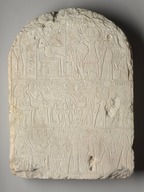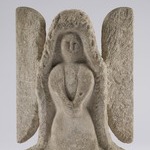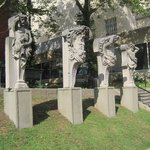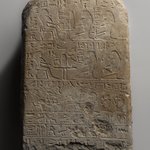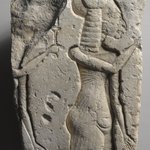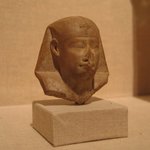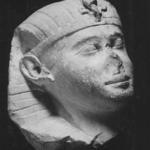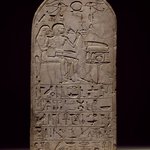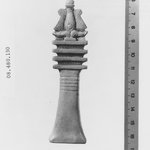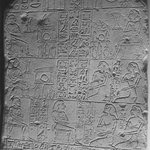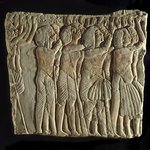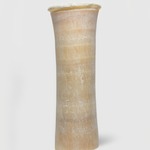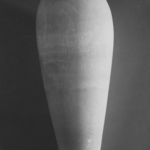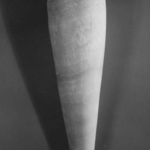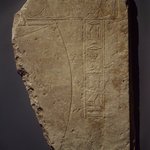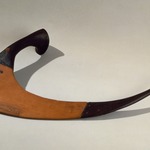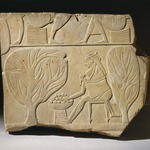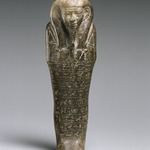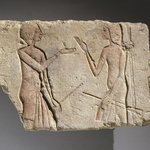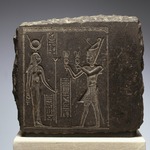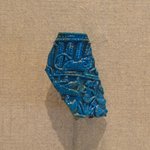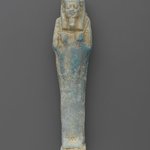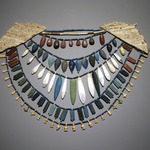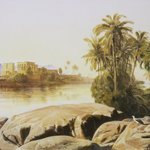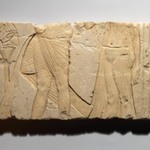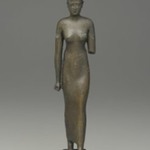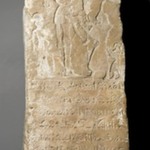Stela of Penamun
Egyptian, Classical, Ancient Near Eastern Art
In the upper register of this funerary stela, a man named Penamun, his wife, and one of their sons present offerings to the god Osiris, behind whom stands the goddess Isis. In the middle register, Penamun and his wife sit before a table of offerings. Facing them are a lector priest, a professional singer in an attitude of mourning, and one of their daughters. In the bottom register another man and his wife receive offerings from their children. The registers are meant to suggest different realms of existence. The upper register is the realm of the netherworld, the middle that of the tomb, and the bottom that of the living.
MEDIUM
Limestone
DATES
ca. 1334-1295 B.C.E.
DYNASTY
late Dynasty 18
PERIOD
New Kingdom
DIMENSIONS
25 15/16 × 18 1/16 × 3 1/8 in., 82 lb. (65.9 × 45.9 × 7.9 cm, 37.19kg)
(show scale)
ACCESSION NUMBER
37.1486E
CREDIT LINE
Charles Edwin Wilbour Fund
CATALOGUE DESCRIPTION
One round-topped funerary stela of the man Penamun and his wife Mutemwiya. At the top of the stela Penamun is shown before Osiris and a goddess. He strides forward towards the seated god with offerings of formal bouquets as does his wife. Close behind follows a retainer carrying a duck and more floral offerings. The second register shows Penamun seated with his wife before and offering table laden with foodstuffs. On the opposite side of the table and approaching is seen a priest with censer, his arm raised toward the couple followed by two mourning women. The third register repeats the above scene, except that a female offerings bearer leads the way for two men. The first carries a young animal across his shoulders, the second papyrus and a vase. The last figure is that of a woman carrying a formal bouquet. All of the above is executed in shallow sunk relief. Registers of hieroglyphs fill all the extant space between and above the figurative representations.
Condition: The top of the stela has suffered much damage, the registers of hieroglyphs appearing there having been chipped away to the level of the figures. The top of the goddess on the left has been damaged, her crown has been lost and the figure of Osiris likewise. The figure of the retainer on the far right lacks a head; the woman in front has been damaged by a circular chip in the side of the head, extending over part of the face. A shallow flake has removed a strip of surface running through the goddess' body and continuing onto the throne of the figure of Osiris. A small chip is missing from just in front of the figure of Penamun. The second register has fared better, but a large gouge has been taken out of the right hand side (partially obliterating the figure of the second mourner) by a chisel. Three strokes are visible. Some iron staining is visible at the far right, as well as left. The bottom register is marred by a large loss, directly below the figure of Penamun, in the form of a chip. The offering bearers have been damaged. The bearer with the young animal has two circular depressions resembling drill-holes, over his lower body; some iron staining is noted here, also. A second large chip is seen beneath the final bearer on the far right. The borders of the stela are much chipped all round. No trace of gesso or color is noted.
MUSEUM LOCATION
This item is not on view
CAPTION
Stela of Penamun, ca. 1334-1295 B.C.E. Limestone, 25 15/16 × 18 1/16 × 3 1/8 in., 82 lb. (65.9 × 45.9 × 7.9 cm, 37.19kg). Brooklyn Museum, Charles Edwin Wilbour Fund, 37.1486E. Creative Commons-BY (Photo: Brooklyn Museum, 37.1486E_PS9.jpg)
IMAGE
overall, 37.1486E_PS9.jpg. Brooklyn Museum photograph, 2016
"CUR" at the beginning of an image file name means that the image was created by a curatorial staff member. These study images may be digital point-and-shoot photographs, when we don\'t yet have high-quality studio photography, or they may be scans of older negatives, slides, or photographic prints, providing historical documentation of the object.
RIGHTS STATEMENT
Creative Commons-BY
You may download and use Brooklyn Museum images of this three-dimensional work in accordance with a
Creative Commons license. Fair use, as understood under the United States Copyright Act, may also apply.
Please include caption information from this page and credit the Brooklyn Museum. If you need a high resolution file, please fill out our online
application form (charges apply).
For further information about copyright, we recommend resources at the
United States Library of Congress,
Cornell University,
Copyright and Cultural Institutions: Guidelines for U.S. Libraries, Archives, and Museums, and
Copyright Watch.
For more information about the Museum's rights project, including how rights types are assigned, please see our
blog posts on copyright.
If you have any information regarding this work and rights to it, please contact
copyright@brooklynmuseum.org.
RECORD COMPLETENESS
Not every record you will find here is complete. More information is available for some works than for others, and some entries have been updated more recently. Records are frequently reviewed and revised, and
we welcome any additional information you might have.


